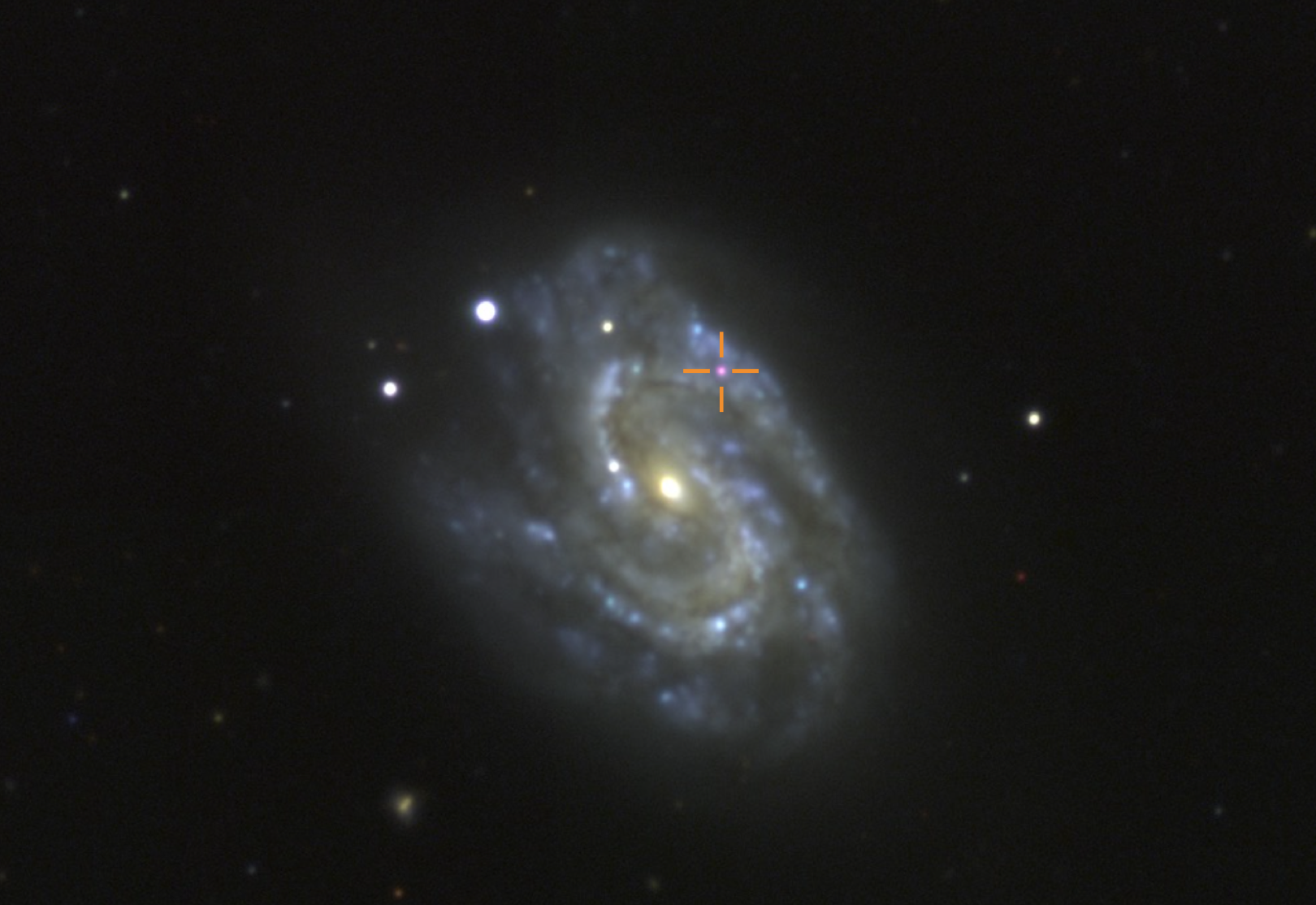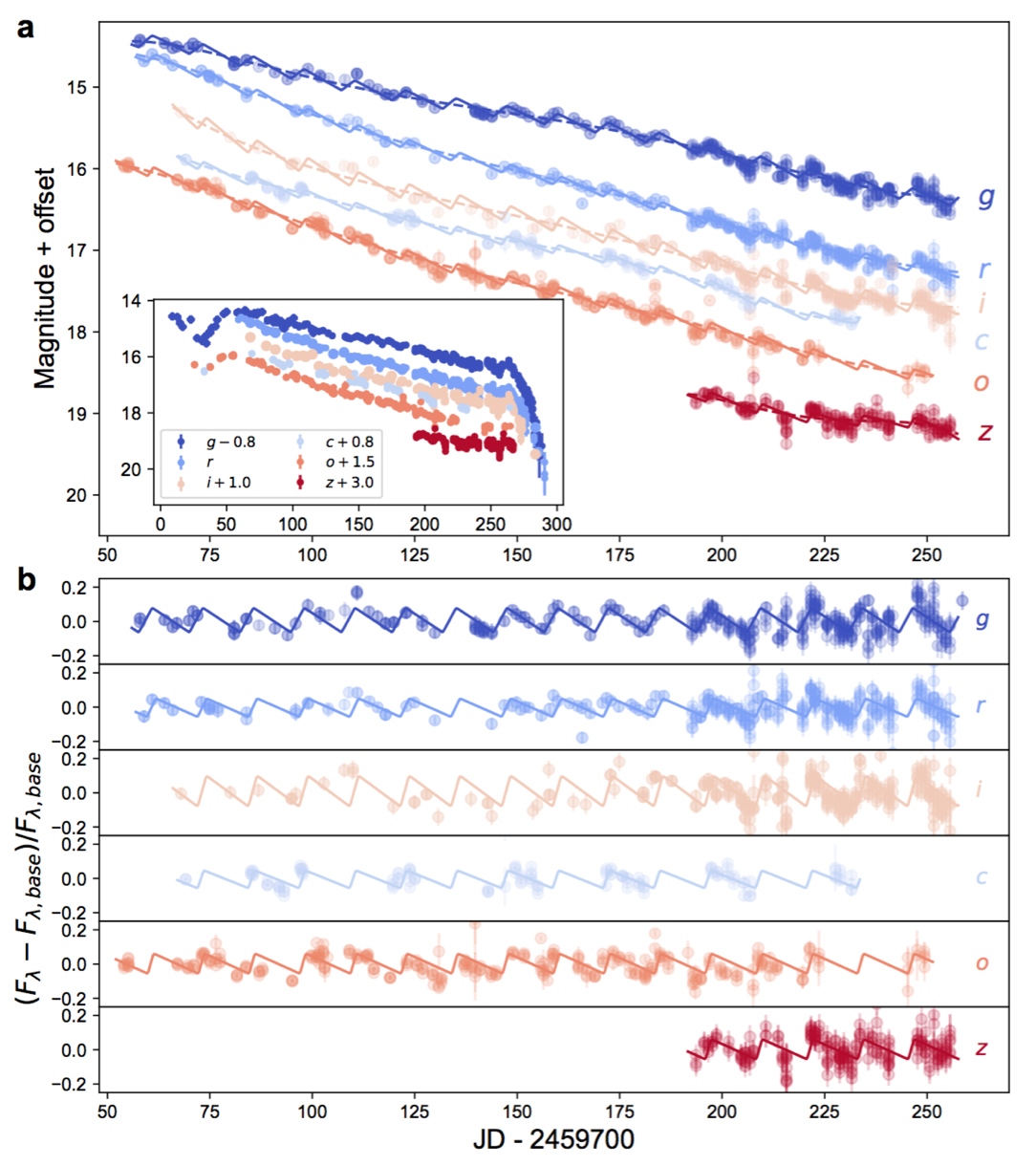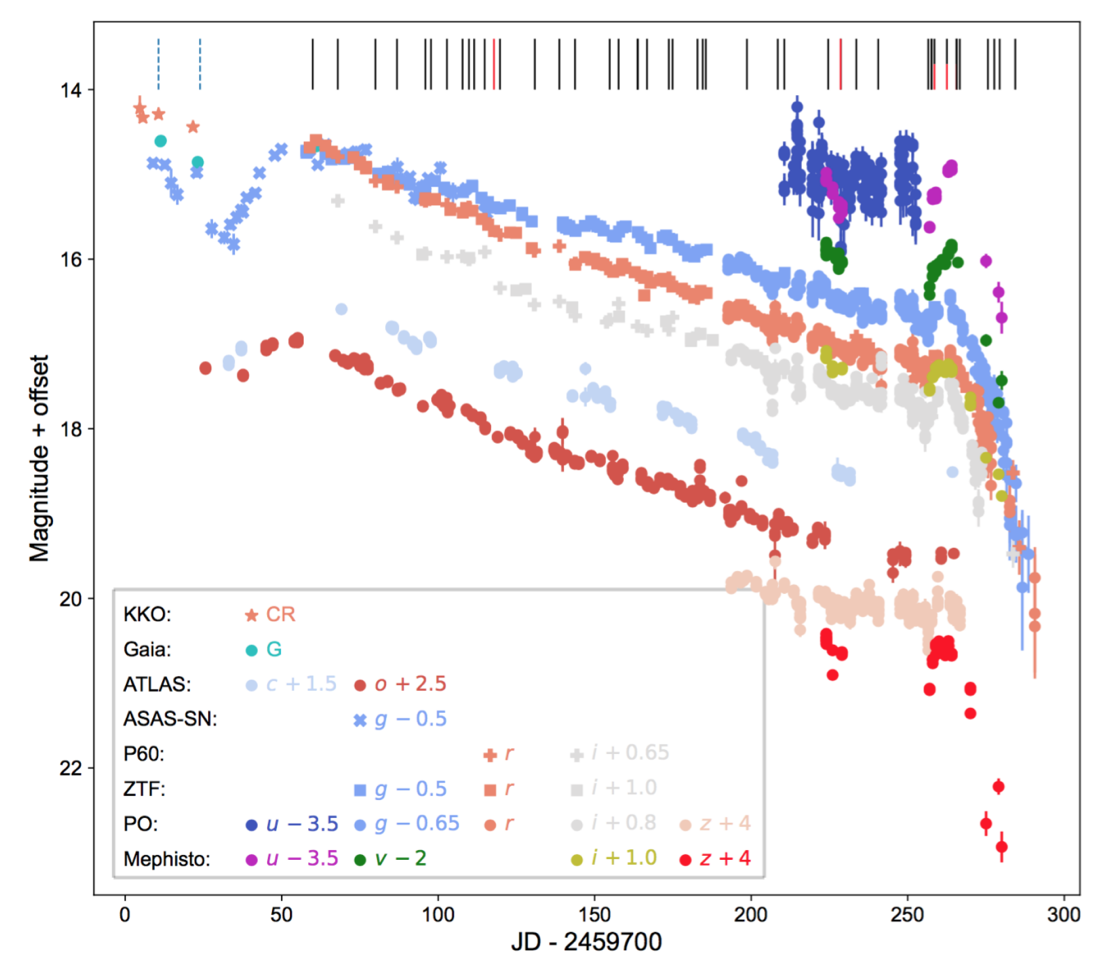梦飞巡天望远镜初显身手,参与超新星SN2022jli国际联测获得重大发现
Mephisto participated in an international campaign of monitoring SN2022jli and obtained major discovery
2024年1月10日,《自然》杂志主刊发文报道了天文学家近期的重大发现,超新星SN2022jli的光变曲线衰减存在12.4天的周期性起伏,其同期光谱的Hα窄发射线也表现出一致的周期性速度位移。这个首次在超新星爆发过程中观测到的特征表明,SN2022jli起源于一个双星系统中大质量恒星的爆发,新诞生的致密天体通过吸积伴星为超新星爆发提供了额外的能量。云南大学中国西南天文研究所梦飞巡天望远镜项目团队成员刘晓为教授、刘项琨教授、刘德子副研究员、方圆副研究员参与了该项研究。梦飞巡天望远镜的地理优势及提供的高精度多波段测光数据为这一重大发现的取得发挥了重要作用。
超新星爆发是宇宙中最剧烈的爆发现象之一,峰值光度与整个星系的亮度相当。大质量恒星在其演化晚期,当星核的辐射压无法抵抗其自身引力时,星核就会坍塌产生超新星爆发并诞生致密天体(中子星或者黑洞)。宇宙中许多大质量恒星处于密近双星系统中。天文学家预测超新星爆发将对双星系统演化产生重要影响,爆发新诞生的致密天体也会吸积伴星物质并产生辐射。然而,人们一直未确实找到超新星爆发于双星系统的证据。
2022年5月5日,超新星SN2022jli被Libert Monard发现后很快得到世界各地巡天项目的确认。该超新星被分类为Ic型超新星,爆发于近邻星系NGC 157的悬臂中,距地球7100万光年。在对该超新星的监测过程中,天文学家注意到SN2022jli的光变曲线演化呈现小幅振荡扰动的特征。为核实这一观测事实并厘清其物理起因,以色列魏茨曼科学研究所牵头组织了针对SN2022jli的国际联测。云南大学梦飞巡天望远镜参与其中,对SN2022jli进行了长达两个月的持续监测,提供了重要且与其它参与联测台站高度互补的多波段测光数据,为SN2022jli的后续科学分析奠定了坚实基础。通过对联测数据的细致分析,天文学家获得了上述重大发现。
《自然》杂志的审稿人对该发现给予高度评价,认为“该工作首次探测到超新星爆发过程中的光变和谱线的周期性调制,并对周期性的起源提供了合理的物理解释,是一个非常具有说服力的案例”,“这一发现为理解超新星的能量供给和双星起源迈出了重要的一步”。美国内华达大学拉斯维加斯分校内华达天体物理中心的特聘教授及创办主任张冰教授指出:“SN2022jli中12.4天周期的发现意义重大。从引力波数据中,我们经常看到两次超新星爆发后产生的双星致密天体。这就要求超新星发生在双星系统中,并且双星系统在爆发后保持束缚。这是我们第一次从观测上真正目睹这样一个过程。梦飞巡天望远镜对这一事件的测光观测作出的贡献值得称赞”。中国科学院紫金山天文台副台长吴雪峰研究员评论道:“梦飞巡天望远镜专为多波段同时测光观测所设计。该设备在丽江的初期调试运行过程中就参与到SN2022jli这颗Ic型超新星爆发后220—276天内的多色后随观测,为揭示i和z波段12.4天的周期性起伏,以及爆发260天之后的uviz多波段快速衰减,提供了重要观测数据。这类周期性信号首次在超新星观测中被发现,对揭示大质量恒星的晚期演化和引力坍缩过程有重要意义。这次国际联测所取得的重要成果,从观测上表明云南大学梦飞巡天望远镜在国际时域天文观测领域具有独特优势和重要价值”。
云南大学梦飞巡天望远镜(Mephisto)是云南大学“双一流”重点建设的重大科研平台,是国际首台大视场、多通道、高精度成像测光巡天望远镜。其独特优势在于可同时在3个波段拍摄天体图像,提供天体超高精度亮度及颜色信息,实现对海量变源暂现源的快速证认、分类及物理性质研究,录制宇宙天体运动和变化的彩色纪录片。2022年9月,梦飞巡天望远镜在丽江高美古观测站安装调试,同年10月23日实现小系统双通道四波段(uviz)初光。2023年12月21日,首次实现蓝黄红三通道同时出光,12月27日,梦飞巡天望远镜发布首帧真彩色天图。梦飞巡天望远镜2022年12月10日至2023年2月6日参与了SN2022jli的国际联测,对其持续开展多波段同时观测。
梦飞巡天望远镜由云南大学中国西南天文研究所牵头研制和运行。望远镜主体由南京天文光学技术研究所负责研制,观测台站建设由中国西南天文研究所与云南天文台合作共同完成。梦飞巡天望远镜项目得到了云南省政府和云南大学“双一流”建设经费的支持。项目团队还得到了云南省兴滇英才支持计划“科技领军人才专项”(202005AB160002)、“创新团队”(202105AE160021) 和“顶尖团队”(202305AT350002)项目支持。
发表文章链接:https://www.nature.com/articles/s41586-023-06787-x 。
预印版链接:https://arxiv.org/abs/2310.07784 。

图1. 梦飞巡天望远镜拍摄的 SN2022jli及宿主星系NGC 157真彩色图。
Figure 1. True color image of SN2022jli and the host galaxy NGC157, captured by Mephisto.

图2. SN2022jli存在周期性起伏的多波段光变曲线。
Figure 2. Multi-band light curves of SN2022jli show periodic undulations.

图3. 超新星SN2022jli的光变曲线,包括梦飞巡天望远镜(Mephisto)的观测数据。
Figure 3. Light curves of SN2022jli, including the measurements of Mephisto.

On January 10, 2024, the Nature journal published an article reporting on a major discovery in astronomy. The declining light curve of SN2022jli exhibits a periodic undulations of 12.4 days, meanwhile, the narrow Hα emission detected in the contemporaneous spectra of this supernova also shows concordant periodic velocity shifts. These features were first discovered in the observation of a supernova, indicating that SN2022jli originated from the explosion of a massive star in a binary system and the periodic mass accretion from the companion star onto the newly formed compact object provides the extra power to the supernova explosion. Mephisto team members, Drs. Xiaowei Liu, Xiangkun Liu, Dezi Liu, and Yuan Fang, from South-Western Institute For Astronomy Research at Yunnan University (SWIFAR-YNU), participated in this major international campaign. The unique geographical location of and the high-quality multi-band photometric data provided by Mephisto play an important role in this major discovery.
Supernovae are one of the most violent explosive phenomena in the universe. The peak luminosity of a supernova is comparable to the luminosity of the entire galaxy. When the radiation pressure from nuclear fusion in the core of a star cannot resist its own gravity, the star core collapses, resulting in a supernova explosion and compact objects (neutron stars or black holes). Many massive stars in the universe are in close binary systems. Astronomers predicted that supernova explosions will affect the evolution of binary systems, and that newly born compact objects will accrete the medium from companion stars to generate radiation. However, signatures of binarity for a supernova explosion remain elusive hitherto.
On May 5, 2022, the supernova SN2022jli was discovered by Liberty Monitor and quickly confirmed by the survey projects around the world. This supernova is classified as an Ic type supernova and was born in the spiral arm of the nearby galaxy NGC 157, at a distance of 71 million light years from us. During the early observation, astronomers found that the light curve of SN2022jli exhibited some oscillation features. To verify this, the Weizmann Institute of Science of Israel initiated an international campaign of monitoring SN2022jli. Multi-channel Photometric Survey Telescope (Mephisto) of Yunnan University participated in this campaign, and continuously monitored SN2022jli for 2 months, providing important and highly complementary multi-band photometric data for the subsequent scientific analyses. Subsequent detailed analyses of those data revealed the major discovery mentioned above.
The reviewers of the Nature journal gave a high appraisal to the discovery, and commented that “The article presents a very convincing case for the detection of short period variations (12.4 days) in the light curves and spectral features of a stripped-envelope supernova. There is no doubt about the existence of this periodic modulation, which is detected for the first time…The proposed explanation is very reasonable”, “This discovery represents a major step forward for the field of explosive transients and our understanding of the power sources of supernovae and for our understanding of the progenitors of supernovae, in particular binaries”. Prof. Bing Zhang, a distinguished professor and founding Director of Nevada Center for Astrophysics, University of Nevada, Las Vegas, commented that “The discovery of a 12.4-day periodicity in SN2022jli is very significant. From gravitational wave data we often see binary compact objects that are descendants of two supernova explosions. This requires that supernovae happen in binaries and the system remains bound after the explosions. This is the first time that we actually witnessed such a process observationally. The Mephisto contribution to the photometry observations of this event is commendable”. Prof. Xuefeng Wu, Deputy Director of Purple Mountain Observatory, Chinese Academy of Sciences, commented that “Mephisto telescope is designed for multi-band simultaneous photometric observations, and participated in the multi-band follow-up observations of SN 2022jli during its commissioning in Lijiang. The multi-band photometry provides important clues in revealing the periodic undulations of 12.4 days in the i- and z-bands and the fast decline in the uviz band after 260 days of the eruption of SN2022jli. This periodic undulation signals were first discovered in supernova observations, which has significant implications in unveiling the late evolution and gravitational collapse processes of massive stars. The important achievements of this international campaign indicate that Mephisto telescope of Yunnan University has unique advantages and important scientific value in the field of international time-domain astronomical observations”.
Mephisto is a 1.6-m wide-field multi-channel telescope, the first of its type in the world, capable of imaging the same field of view in three optical bands simultaneously. It will yield real-time, high-quality colors of unprecedented accuracy of billions of objects, enable fast and robust classification of variables and transients, and for the first time, deliver a panoramic and panchromatic documentary of our dynamic universe. The on-site telescope assemblage and commissioning began in September 2022, and the first light in dual channels of four bands (uviz) for a pilot system covering one quarter of the full field of view was achieved on October 23, 2022. On December 21, 2023, Mephisto achieved imaging in three channels simultaneously for the first time, and released the first true color images on December 27, 2023. In the international campaign of monitoring SN2022jli in NGC157, Mephisto performed multi-band simultaneous observations from December 10, 2022 to February 6, 2023.
Mephisto is developed at and operated by SWIFAR-YNU, funded by the “Yunnan University Development Plan for World-Class University” and “Yunnan University Development Plan for World-Class Astronomy Discipline”. The telescope was built by Nanjing Institute of Astronomical Optics & Technology. The telescope on-site infrastructure was developed in collaboration with Yunnan Astronomical Observatories. The Mephisto team also receives support from the “Science & Technology Champion Project” (202005AB160002) and from two “Team Projects” -- the “Innovation Team” (202105AE160021) and the “Top Team” (202305AT350002), all funded by the “Yunnan Revitalization Talent Support Program”.
Published paper link: https://www.nature.com/articles/s41586-023-06787-x.
arXiv version link: https://arxiv.org/abs/2310.07784.
